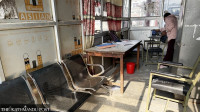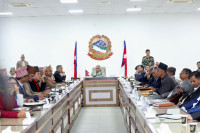National
Nepalis rescued from Manipur brought to Kathmandu
A total of 179 Nepali citizens—147 women and 32 men—who were rescued in a massive operation in northeastern state of India, Manipur, were brought to Kathmandu on Wednesday.
Chandan Kumar Mandal
A total of 179 Nepali citizens—147 women and 32 men—who were rescued in a massive operation in northeastern state of India, Manipur, were brought to Kathmandu on Wednesday.
Their repatriation came three weeks after they were rescued in the two-day operation in various parts of Manipur state.
A government team brought all of them back in six buses to the Capital after they were first brought to Kakadbhitta, an eastern city bordering India. The Manipur state government and local activists had made arrangements for sending them back to Nepal.
Krishna Bhushal, under-secretary and chief of Human Trafficking Control Section under the Ministry of Women, Children and Senior Citizen, told the Post most of them are in good health condition.
“Most of them are in normal condition, but they are tired after a long journey,” Bhushal said.
These human trafficking survivors have been kept in various shelter homes for now. According to Bhushal, Maiti Nepal has 94, followed by Pravasi Nepali Coordination Committee (32), Paurakhi Nepal (20), Aprabasi Mahila Kamdar Samuha (15), Shakti Samuha (10), and Saathi (8).
“They will be kept here for some time for socio-psycho counseling while the investigation on how they landed up in the trap of human traffickers goes on,” Bhushal said. Many of the rescued persons hail from districts in the East.
Acting on the tip-off from the Maiti Nepal that a large number of Nepali citizens were trafficked to southeast Asian and Gulf countries via India-Myanmar border, the Meghalaya-based Impulse NGO Network had informed the local authority which acted immediately and foiled the trafficking in the first week of February.
They were rescued from Imphal Airport, various hotels from across Manipur before they would cross Moreh–that falls along the India-Myanmar border.
Then, the Nepali Embassy in New Delhi sent a team for their verification and repatriation.
“We have to find out how they become victim of human trafficking. Some of them might have chosen themselves, others might have been lured while others might have no idea where they were being taken to,” Bhushal told the Post.
Trafficking of Nepali citizens via land routes have emerged as the challenge for the law enforcing authority. After Indian airports have started asking for ‘No Objection’ letter from the Nepali Embassy in New Delhi, traffickers have started using overland routes for transporting persons to other countries. A total of 36 women–who were being trafficked to India via Birgunj–have been rescued in the last three months.
“Open border has been a challenge for controlling human trafficking. People also opt to migrate to other countries via illegal channels in search of jobs as the country cannot provide enough employment opportunities,” said Bhushal.
“The recent crackdown and success in stopping such a large number of people will discourage traffickers operating in the region.”




 19.12°C Kathmandu
19.12°C Kathmandu















